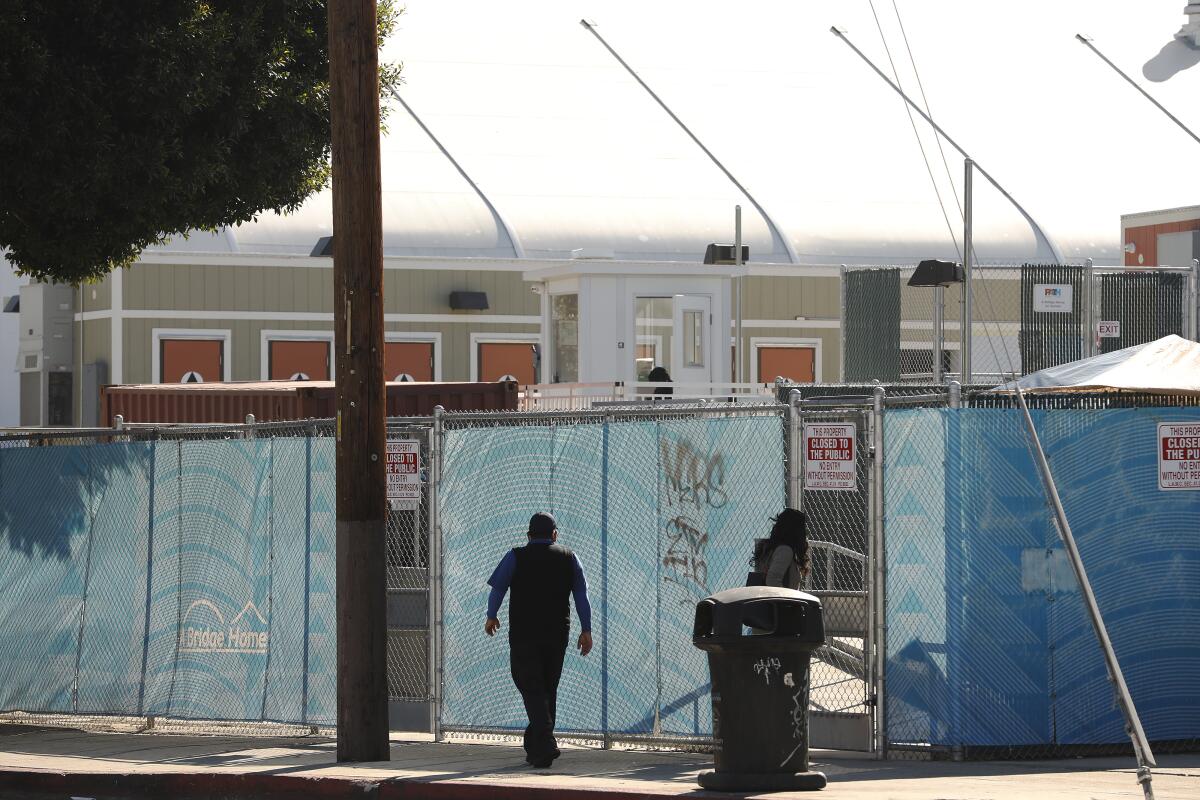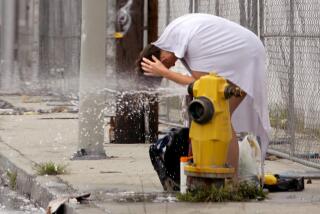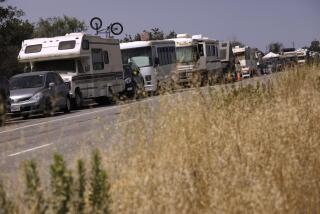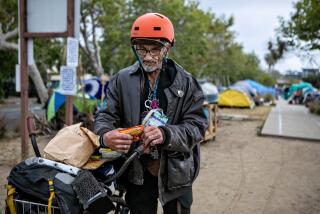L.A. wanted the Venice homeless shelter open at full capacity. Now it has a COVID outbreak

- Share via
At a city-funded homeless shelter in Venice, 37 people have tested positive for the coronavirus in recent weeks — the largest current outbreak in a homeless facility in Los Angeles.
The 154-bed site is on lockdown and no new people are being admitted.
This comes after city officials pushed for the site to be reopened at full capacity in the spring despite concerns of medical officials at the Department of Health Services.
In mid-May, L.A. city officials organized a call with some of the nonprofit providers that run the largest city-funded homeless shelters.
Placing a shelter in Venice has been a hot button issue for years. It was pushed through by Mayor Eric Garcetti and Councilman Mike Bonin over intense opposition and opened just before the pandemic came into full force. The complex, on a vacant Metropolitan Transit Authority storage yard, has multiple buildings. There’s a large tent-like structure that is meant to hold 100 adults and trailers that are meant for 54 young adults between 18 and 24.
Anger over homelessness in Venice reached new heights in recent months as large numbers of tents popped up on the boardwalk and residents expressed frustration over how many people were living on nearby streets and sidewalks. Throughout June and July the city strove to move more than 200 people from the boardwalk and find them a place to stay.
At the time, the number of people testing positive for COVID-19 was down and the city was contending with public anger over large encampments. City officials needed more space to put people and wanted shelters to be at full capacity.
“There was a strong recommendation from the city that we ‘recompress,’” said Jennifer Hark-Dietz, deputy chief executive officer and executive director of PATH, a statewide homeless housing and services agency, which manages the shelter where the outbreak took place.
That recommendation was made on May 14, she said. That was well before the latest surge in COVID cases driven by the Delta variant.
“Our concern was exactly what happened, which is an outbreak like this,” she added. “What we all have to do is really weigh what the risk is of being in a site where you can contract the virus versus being outside.”
Still, with cases on the decline and the ability to robustly test and vaccinate people, Hark-Dietz said her team thought that bringing more people indoors was better than just letting them stay on the street where they have less access to housing and medical services.
Deputy Mayor for Homelessness Jose “Che” Ramirez echoed her sentiment, saying city officials wanted to help as many people as possible get off the streets.
“We have all these beds that we need that are precious resources, and we have folks that are vulnerable that we need to bring indoors,” Ramirez said, explaining city officials’ rationale. The goal was to start with a few sites and slowly expand the population at each one, while offering increased testing and vaccinations.
Hark-Dietz explained that after consultations with the L.A. Department of Health Services, the shelter went from holding 75 people to 100, which was its population before March 2020. By July 26, the first positive cases were reported, she said, and as of Thursday there were 35 cases among homeless people and two among staff.
Los Angeles Mayor Eric Garcetti trumpeted his homeless program, A Bridge Home, as a means to shore up the supply of interim housing. Results have been mixed.
People who tested positive have been moved to quarantine and isolation facilities. Sixty remain inside the shelter and PATH is not moving anyone else in, she said. Two people who had been staying at the shelter died in late July, according to Hark-Dietz. She said one overdosed and the other cause is unknown, but both were confirmed to have had COVID-19.
City officials told Hark-Dietz and two other shelter operators, the Salvation Army and Hope of the Valley, that the Los Angeles Homeless Services Authority agreed with the plan to increase the capacity of certain shelters, according to emails obtained by The Times.
Loyda Peraza, who runs the Salvation Army’s Van Nuys shelter, which is funded by the city, said she is working to bring the facility to its full capacity of 70 beds, up from 48, but that effort has been slowed by a COVID outbreak in late July. She said neither of the Salvation Army’s two other city-funded shelters are at full capacity.
It’s not clear if the shelter operated by Hope of the Valley is back to full capacity. Representatives didn’t respond to requests for comment. LAHSA spokesman Ahmad Chapman wouldn’t comment about increasing the capacity of the Venice shelter but said the agency “encourages its providers to abide by Department of Public Health orders and recommendations.”
There have been some smaller outbreaks at city-funded facilities but none as large as the one in Venice.
Dr. Heidi Behforouz, medical director for L.A. County’s Housing for Health program, which helps homeless people across the county, said that the Department of Health Services has no regulatory role in how shelters should be run. That is the purview of the L.A. County Department of Public Health. Her team has been worried that the move to get people back inside congregate spaces was premature. The numbers of homeless people who are vaccinated is still quite low and the Delta variant is far more contagious than its predecessors.
As of July 19, just 43% of Los Angeles County’s homeless population had received one vaccine dose and 33% of the population was fully vaccinated, according to data from the Los Angeles County Department of Public Health.
“We have told the city ... if you’re thinking of recompressing, at least call a COVID response team so that we can come in and just give you some advice,” Behforouz said. “But we are not in a position to say ‘don’t.’ All we can do is say OK, so you get pressured to recompress, at least please be sure to do this, that and the other thing, but whether or not they follow that we have no control.”
In early June, a DHS official visited the site and put in writing some recommendations about how to keep it safe, according to a memo obtained by The Times.
The Los Angeles County Department of Public Health said in an email that since mid-June, spacing protocols have been at the discretion of providers, even in city-funded shelters. In addition to universal masking and directions about ventilation, the agency recommended at least six feet of space between beds whenever possible, three feet when it isn’t. That guidance hasn’t changed.
“We’ve certainly offered our general shelter guidance to the city but we have not been involved in or aware of specific operational plans of that facility or other [city-funded] facilities,” a spokesman for the agency, Bernard Tolliver, said by email.
More to Read
Sign up for Essential California
The most important California stories and recommendations in your inbox every morning.
You may occasionally receive promotional content from the Los Angeles Times.









